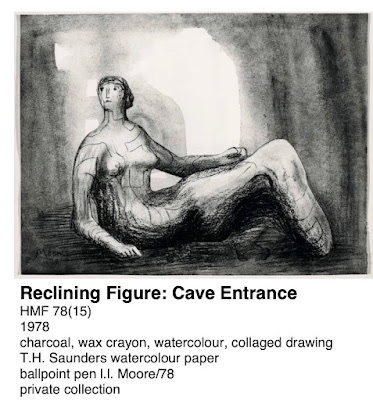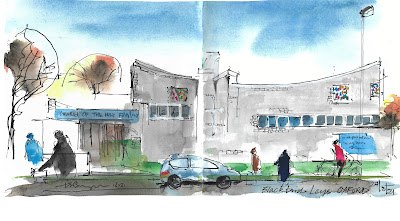Most of our workshops at art school conclude with a tsunami of links and suggestions of artists we should investigate and through this enquiry determine the his/her importance and relevance to one’s own work (practice). Note the use of the word ‘practise’ to imbue the practise of painting and related active with supplementary airs and graces.
Henry Moore was called out a couple of weeks back. My diligence led to this:
Drawing to Sculpt.
Henry Moore was a sculptor passionate about drawing. In the online the archive of his work, there are 1678 landscape drawings.
He works in charcoal, wax crayon (wax resist) watercolour collage. When the ball point pen was available that was a favourite.
Moore has been drawing in sketchbooks throughout his life. He takes these drawings into printmaking as well as sculpture. He led the post war sculpture revival. and he has always looked carefully at his drawings to see how they could become sculpture.
His leitmotif is the reclining nude. It is easy to see how he draws parallels with reclining nude and the landscape. There was an interesting passage in a BBC film about him [details below] where he takes a drawing by Albrecht Durer and sees lines on that drawing becoming landscape.
BBC film was shot in 1978 interview with John Read. In the film we see his landscape drawings, use of wax resist, as he walks us through his sketchbook. Moore has been a constant drawer working away at ideas.
The countryside was always hugely important to Henry Moore. Exemplified by a series of drawings of tree drawings on blotting paper. He looks at tree roots and says they look like figures “tree trunks are human, almost” 39:09 min into the BBC film*.
Aside from being one of the most important sculptors of late 20th century his drawings are a rich resource.
“Drawing from nature makes you look more intensely” says Moore in his interview
The Henry Moore Foundation is embarking on an exciting new project to publish Henry Moore’s entire artistic output in one comprehensive and illustrated online catalogue.
https://catalogue.henry-moore.org/search/*/objects?filter=department%3ADrawings
*The Lively Arts - Henry Moore at Eighty (1978 von John Read) (engl.)
9 Jan 2017
moriundmori - Kunst-Dokus
Henry Moore gives a private viewing of his sketches.
BBC 1978, Producer: John Read.
First Broadcast: 30 July 1978
https://www.youtube.com/watch?v=mGWaiB_nraM
Importance and Relevance, oh yes…
I am much in tune with Moore’s dictum ‘Drawing from nature makes you look more intensely’. I always have,
I walk past trees and see their roots and I am smitten by the need to draw them.
Seeing trees and other forms akin to the human form is a great start point for developing a visual language.











